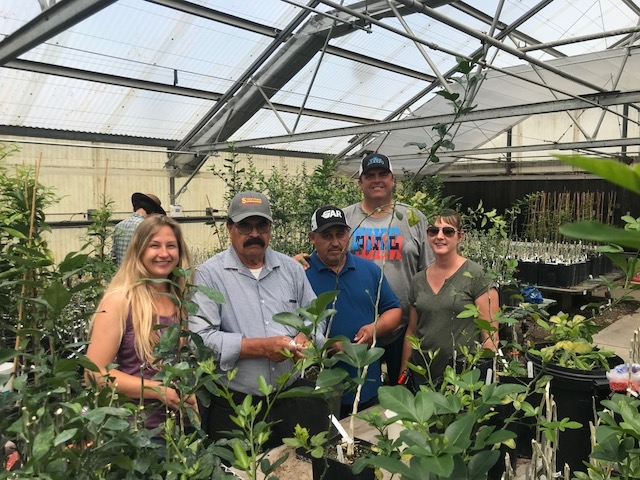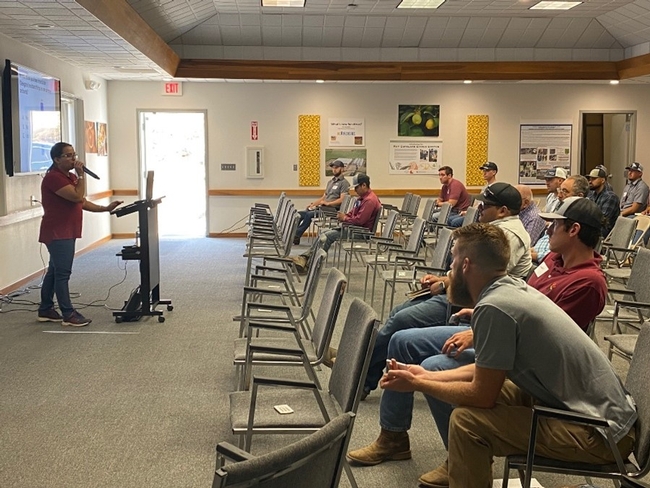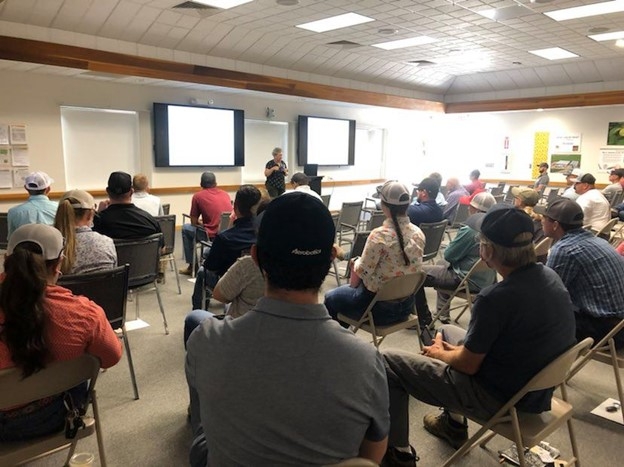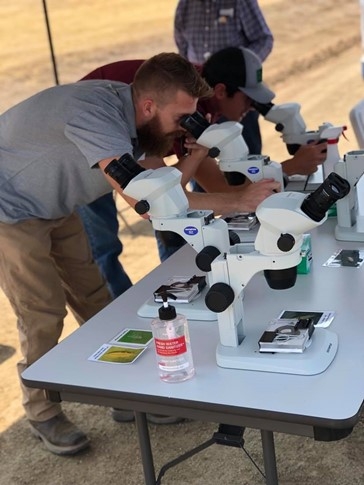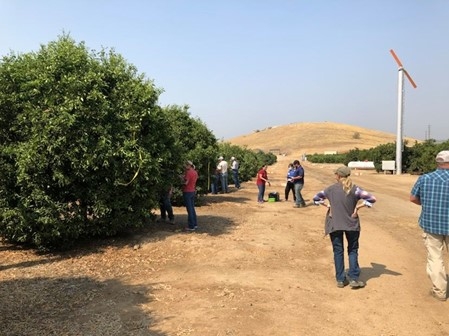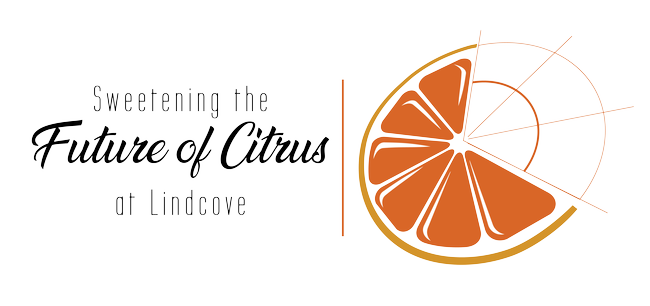- Author: Jasmin Del Toro
On August 25, Lindcove Research Center hosted the first field event of year 2021! A field day was dedicated to discussing information on citrus thrips biology, damage, and management options available. Event kicked off by asking questions to the 42 participants about their pest management needs. Dr. Sandipa Gautam talked about citrus thrips biology and fruit scarring damage on different citrus varieties. Data on citrus thrips resistance to Delegate showed that resistance in San Joaquin Valley populations of citrus thrips is increasing and this is confirmed by PCA and grower observations. This year seemed to be a problem year for citrus thrips, with growers spraying up to five times to control thrips. Dr. Beth Grafton-Cardwell discussed citrus thrips trials screening different chemicals and emphasized the importance of using different class of pesticides for resistant management in citrus thrips. Participants observed thrips and the scarring damage caused by citrus thrips.
Dr. Sandipa Gautam lecturing about citrus thrips
Dr. Grafton Cardwell talking about management options for citrus thrips
Participants observing citrus thrips
Observing thrips scarring and collecting percentage scar data for tangos and clementine's
- Author: Lisa Blecker
- Author: Whitney Brim-DeForest
- Author: A. Katrina Hunter
- Author: Pamela Kan-Rice
While most Californians are staying home to slow the spread of the novel coronavirus, California farmers, farmworkers and other agricultural professionals are out in the fields and packing houses working to produce food.
With increased demand for personal protective equipment, or PPE, to protect against COVID-19, these essential workers are facing shortages. Agricultural commissioners in 28 counties are hearing from farmers who are having trouble getting PPE for their employees and farmers in another 11 counties who are worried about running out of PPE in the next month or twoaccording to a California Department of Pesticide Regulation survey.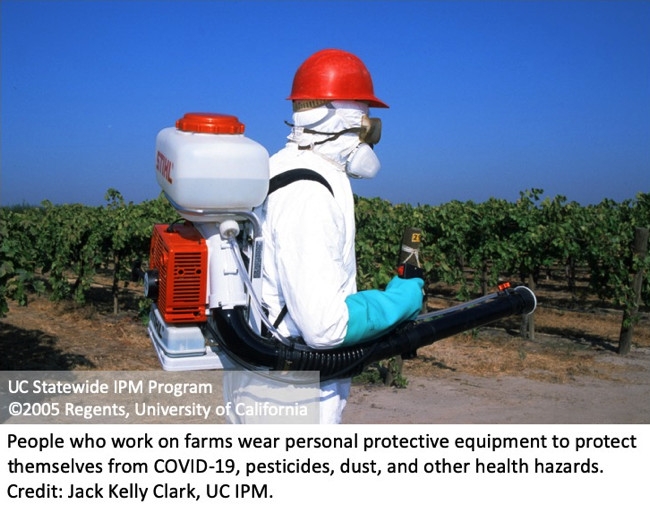
Gloves, N95 respirators, coveralls and other gear that workers wear to protect themselves from COVID-19, pesticides, dust and other health hazards are in short supply as priority is given to health care workers during the pandemic.
To reduce the spread of COVID-19, workers may wear homemade face coverings, but for applying pesticides, they must wear respirators specified on the pesticide product label, said Whitney Brim-DeForest, UC Cooperative Extension rice advisor.
Pesticide applicators may use gear that is more protective than required by the product label and regulations.
“Although this could change in the days ahead, half-mask and full-mask respirators are more available than disposable N95 respirators for now,” said Lisa Blecker, coordinator for the UC Pesticide Safety Education Program.
Before the pandemic, 10% of N95 respirators from 3M went to health care, but that number is now 90%, the company said in a letter to distributors. This has led to significant backorders of PPE supplies for distributors.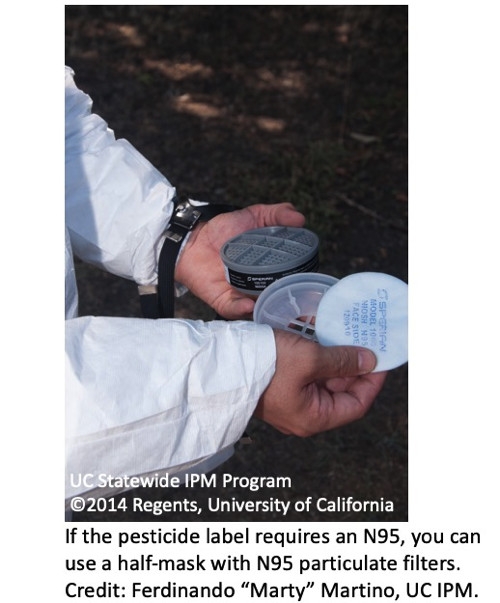
Carl Atwell, president of Gempler's, an online distributor of worker supplies, said that before the crisis, normal lead times for PPE was up to 10 days. He estimated disposable respirators will become available in the fall and other PPE supplies in August.
In the meantime, there is alternative PPE that agricultural professionals can use during the shortage.
Atwell suggests looking for lesser known brands of PPE as opposed to the first tier of choice: “It's sort of like searching for Purell hand sanitizer. Purell brand might be out of stock, but can you find a different disinfectant?”
On Gempler's website, the more recognizable Tyvek coverall from Dupont is sold out, however disposable protective clothing is available from other brands. Reusable chemical-resistant clothing is also available as opposed to their disposable counterparts. Supplies in high demand are reusable and disposable nitrile gloves, protective clothing, disposable respirators and certain protective eyewear, such as goggles and face shields.
For workers who will be applying pesticides, Blecker and Brim-DeForest offered some guidelines on how to meet PPE requirements as the shortage continues.
General PPE requirements: “Remember, the label is the law,” said Brim-DeForest. “PPE requirements for agriculture are not being loosened.” The UCCE advisor recommends purchasing only what you need for the season and choosing reusable PPE whenever possible. Growers who have excess supplies of PPE can coordinate with their county agricultural commissioner or UCCE advisor to help other producers in their area.
Respirators: If you can't find the respirator required on the label, Blecker said, “Use an alternative, more-protective respirator. For example, if an N95 is required, you can use a half-mask with N95 particulate filters; these can be stand-alone filters or ones that attach to an organic vapor cartridge. You could also use a different pesticide that doesn't require a respirator. Consult with your PCA (pest control adviser) for options.”
Gloves: Chemical-resistant gloves, usually 14 mil or more in thickness are required for most California pesticide applications and should be worn by mixers, handlers and applicators. If nitrile gloves are not available, viton and laminate gloves are universal chemical-resistant materials for most pesticide labels. If the glove material is specified on the label, that instruction must be followed.
“Disposable gloves less than 14 mil can be worn, but not for more than 15 minutes at a time,” Blecker said. “Farmers should also note that thinner gloves cannot be layered on top of one another.”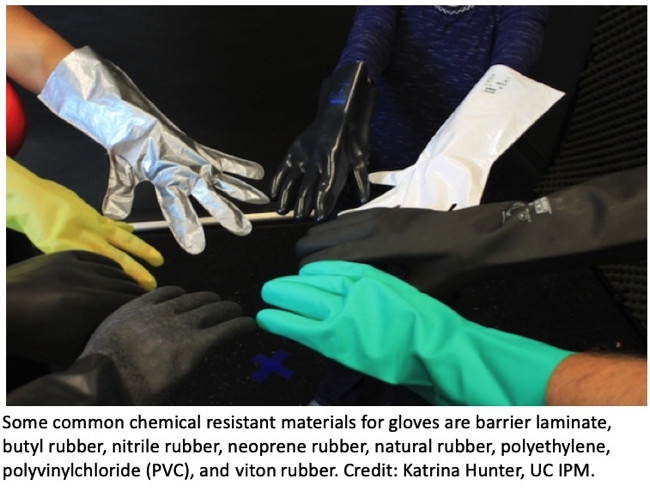
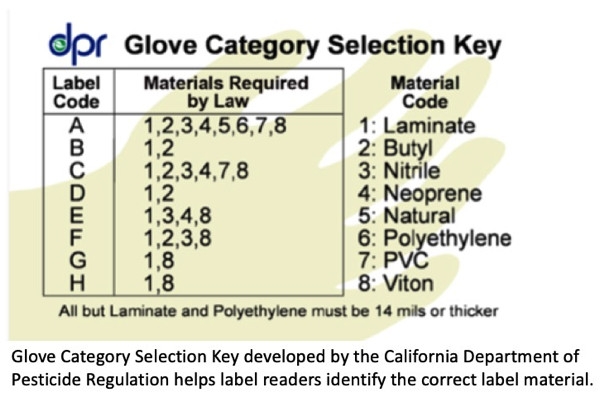
Coveralls: Coveralls should be worn when required by the pesticide label or when the signal word is “WARNING” or “DANGER,” or when applying by backpack or airblast. “Coveralls can be made out of high-density polyethylene fibers (Tyvek and other brands), which are disposable, or cotton, which are reusable,” Brim-DeForest said. “If reusable coveralls are worn, the employer must ensure employees are provided clean coveralls.”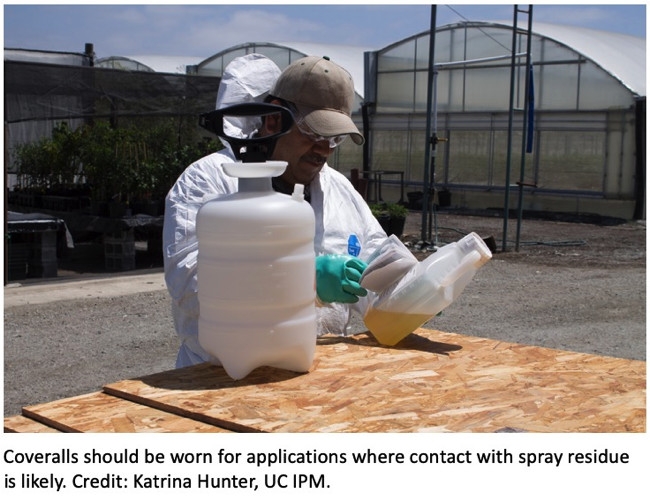
Goggles/face shields: Face shields are required for mixing and loading pesticides only if it's stated on the label. “If a face shield is unavailable, a full-face respirator can be used,” Blecker said. “Goggles or protective eyewear should always be worn in California when handling pesticides, regardless of what the label says. The face shield, goggles or safety glasses must provide front, side and brow protection and meet the American National Standards Institute Z87.1 standard for impact resistance.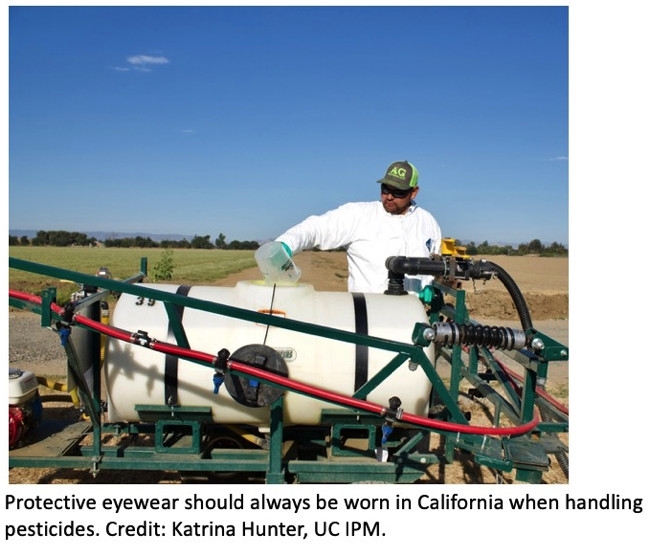
For more information about PPE, contact your county agricultural commissioner or see the California Department of Pesticide Regulation's posters at https://www.cdpr.ca.gov/docs/whs/pdf/gloves_for_pesticide_handling.pdf and
https://www.cdpr.ca.gov/docs/whs/pdf/n95_alternatives_for_pesticide_handling.pdf.
UC IPM also covers these topics in their pesticide safety webinar series at http://ipm.ucanr.edu/IPMPROJECT/workshops.html.
- Author: Elizabeth E Grafton-Cardwell
On Oct 4, Lindcove REC held a Gala event to kick off the start of the fundraising campaign known as Sweetening the Future of Lindcove. Donations will be used as an endowment that will support an educational professional who will greatly expand the outreach capabilities of Lindcove and so help to train the next generation of citrus growers and consumers. The endowment funding will complement UC ANR's plans to expand the conferencing and teaching facilities at Lindcove. If you are interested in making a donation, see the campaign website for more information.
- Author: Elizabeth E Grafton-Cardwell
resentations on citrus thrips, katydid and earwig citrus fruit scarring were made by Jay Rosenheim, Bodil Cass and Hanna Kahl on Aug 21 at a Lindcove Research and Extension Center field day. Exciting new data from their research conducted at LREC shows that thrips, earwigs and katydids dislike feeding on citrus fruit in the Tango group (Citrus reticulata) and this confirms PCA and grower observations that this mandarin variety does not require insecticide treatments for these pests. Other mandarin varieties show varying levels of susceptibility. Beth Grafton-Cardwell and Stephanie Doria discussed their current citrus thrips insecticide trial and best practices for managing thrips.
Presentations can be viewed on the Citrus Entomology Website Training Materials Page.
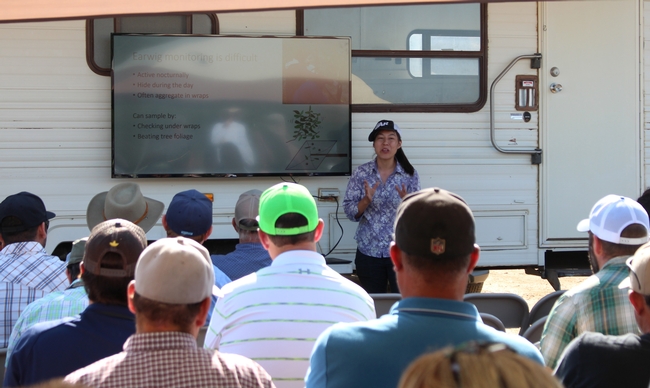
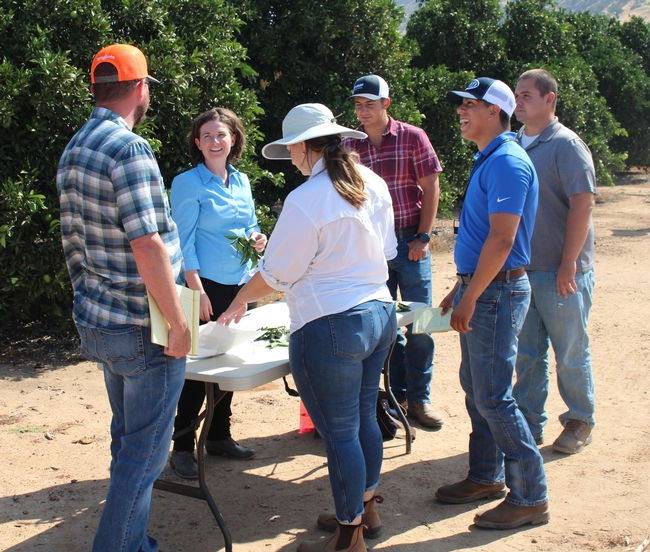
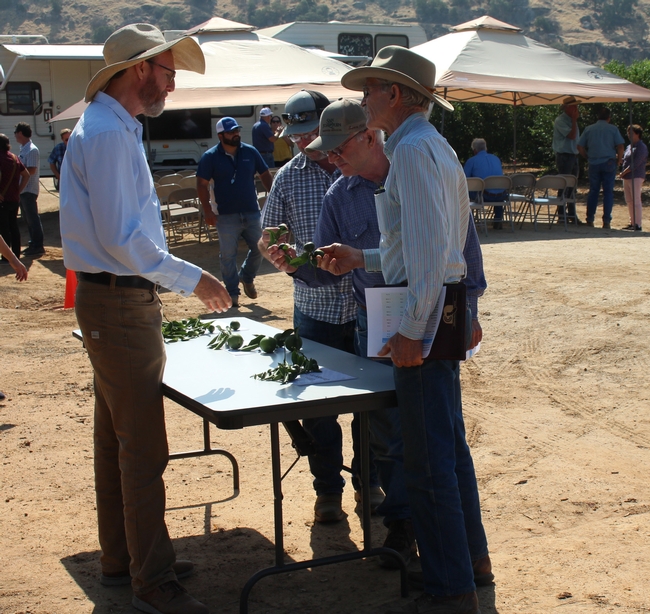
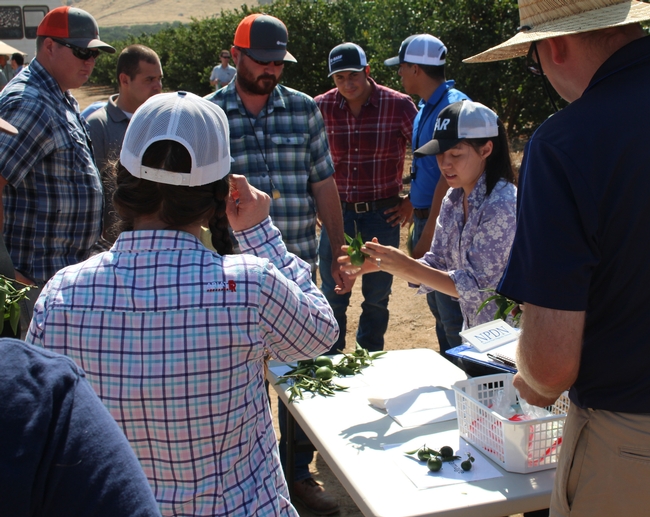


- Author: Elizabeth E Grafton-Cardwell
Each year, Agricultural Technician staff (Donald Cleek, Gerry Perez and Jose Trujillo) from the Lindcove Research and Extension Center travel to UC Riverside to assist the citrus breeding program of DR. Mikeal Roose and Dr. Tracy Kahn by grafting citrus seedlings for various experiments. LREC staff assisted Toni Sievert, Zach Thomas and Carene Trunnelle with budding 965 trees in two days! This is a wonderful example of LREC support of their scientists. 
